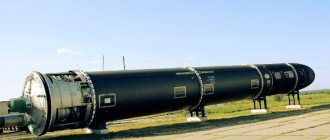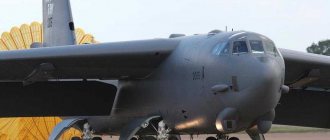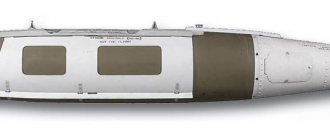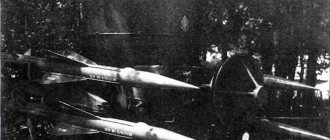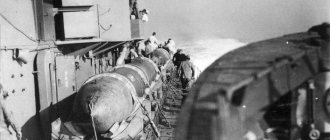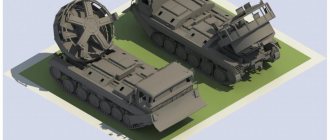"TV bombs"
The F-15E and Su-34 aircraft entered service with the ability to use guided aerial bombs (UAB), which was increased during their modernization. Their advantages are high hit accuracy with the possibility of hitting a target from a distance exceeding the launch line of short-range anti-aircraft missiles, greater warhead power and lower cost compared to tactical air-to-surface missiles. Such ammunition today is extremely diverse in size, warheads and guidance systems.
For the KAB-500Kr adjustable aerial bomb, it is enough that 3 visible landmarks remain on the terrain frame before the hit, and the target itself can even be obscured by smoke Photo: S.G. Freezing
Guided aerial bombs (UAB, in the USSR they were called adjustable bombs - KAB, but they are the same thing) are intended mainly to destroy strongholds and firing points of enemy defenses, buildings and structures, incl. high-strength and underground, positions of fire weapons, as well as ships at the base and on the move. They are used for visible targets - with the naked eye or with the help of electro-optical means operating in the range of light perceived by the eye or thermal.
In the Soviet Union, adjustable bombs for front-line bomber aviation were developed in calibers of 500 and 1500 kg; in Russia they were preserved, but a 250-kg one was added. In America, standard UAB calibers are translated from 227, 454, 908 and 1134 kg pounds, but recently UAB and 113 kg calibers have appeared.
When using television-homing bombs, the operator must see the target on his indicator and place a lock mark on it. After the reset, the pilot can perform an arbitrary maneuver; the target itself will be aimed at the target in its image or at the location on the general frame at the moment of capture - the autocorrelation method ensures a hit, even if at the last moment the aiming point is covered in smoke, but part of the frame with a given number of landmarks will remain free. The homing head (GOS) can be supplemented with a radio command channel, with the help of which the operator controls the flight of the bomb until he receives such a clear image of the target from the GOS that he can give the “capture” command, and only then can he turn away.
The Russian Su-34 carries two to six KAB-500Kr air bombs with television autocorrelation homing. Their circular probable deviation (CPD) in the worst release conditions does not exceed 7 m, but a representative of their developer SNPP Region, in a conversation with the author, stated that, according to an analysis of objective monitoring of the use of such ammunition in the wars in Afghanistan and Chechnya, hits were consistently observed individual parts of small buildings - usually in a door or window, i.e. The CEP of a well-trained crew is 2 m or less.
Heavy adjustable aerial bomb KAB-1500TK developed by SNPP "Region" with television command guidance Photo: S.G. Freezing
There are no such UABs in the F-15E arsenal, but there are twice as heavy GBU-15s, made on the basis of the Mk.84 high-explosive fragmentation bomb or the BLU-109 penetrating bomb. When dropped from a high altitude, they plan for a distance of up to 28 km in autonomous or command mode, but practice shows that the first is used more often and is more effective, although the release range in this way is usually up to 10 km. The Su-34 aircraft can use the KAB-1500TK with a more powerful high-explosive warhead, but at a shorter range; however, again, the maximum is used extremely rarely, and the usual limit is the same 10 km.
Based on this, the rest of the set of “TV bombs” of the Su-34, which do not have a command channel, looks quite rational, but the television one works as an autocorrelator. These are KAB-1500Kr-F with a high-explosive, KAB-1500Kr-Pr with penetrating and KAB-1500Kr-Od with a “vacuum” volumetric detonating warhead, the properties of which we discussed in the previous part of the article.
An important advantage of the Strike Needle remains the ability to use UAB with the thermal imaging command guidance system GBU-15(V)2/B and GBU-15(V)32/B at night, provided there is sufficient infrared contrast of the target. The number of GBU-15 and KAB-1500 bombs mounted under the F-15E and Su-34 is the same - from one to three. But even light snowfall or rain can significantly complicate their use.
The experience of the last world war and subsequent small wars of varying intensity shows that tactical aviation uses bombs of 1000 kg or more caliber much less often than 500, i.e. a combination of Su-34 plus KAB-500Kr is of particular value. Heavier ammunition is needed only against particularly strong structures, such as shelters or dams, and their effectiveness depends on the weight - total, which determines the kinetic energy, and the explosive (explosive, the rest of the damaging effect depends on this). American GBU-15s are lighter, but more accurate, they have a longer gliding range, but this only provides benefits in hitting targets that are not covered by medium-range air defense systems or aircraft, and this is exactly what the nature and value of possible targets suggests for air defense.
Achieving the maximum range of use of heavy bombs involves dropping them from a high altitude, followed by escort by the carrier until the target is captured. The aerodynamics of these bombs require the release speed to be limited to 1100 km/h, which makes the task easier for air defense, so it is safer to approach closer at low level, jump to the minimum release height (about 1000 m) and use the UAB in homing mode.
Table 4-1
Table 4-2
Right on target. Domestic guided bombs
By the beginning of the Second World War, many countries had an urgent need to create guided aircraft weapons, in particular bombs. Free-falling bombs had insufficient accuracy, which in practice resulted in high ammunition consumption and increased risk for the crews of bomber aircraft. In addition, the situation was aggravated by the developing anti-aircraft artillery, which gradually forced the planes to rise higher and higher, losing their bombing accuracy. The way out of this situation was seen in the creation of a bomb that could change the trajectory of its fall and be aimed at a target already in flight. "Crab"
The history of domestic adjustable aircraft bombs began shortly after the end of the Great Patriotic War. Materials for the German project FX-1400 Fritz-X fell into the hands of Soviet engineers. The analysis of the documentation took a long time and only in 1947 the Design Bureau No. 2 of the Ministry of Agricultural Engineering was instructed to develop its own ammunition of a similar type. The theme received the name “Crab” and the index SNAB-3000, and D.V. was appointed chief designer of the project. Candle maker. The terms of reference provided for the creation of a 3000 kilogram caliber guided ammunition with a thermal homing head. Based on the requirements, the general appearance of the new bomb was formed. The ammunition body had an elongated teardrop shape with a characteristic cut in the nose. The latter housed homing equipment. In the middle part of the bomb, four wings were installed in an X-shaped pattern. The presence of wings was due to the need for maneuvering in flight. Without additional planes, the Crab's aerodynamic rudders simply would not be able to provide the proper trajectory correction speed. The leading edge of the wings had a sweep of 30°. The span of each pair of wings is 2520 millimeters. All wing consoles had spoilers measuring 30x350 mm, which were used for roll control. On the narrowed tail of the bomb, a tail was placed, consisting of two stabilizers and two keels. Unlike X-shaped wings, the stabilizers and fins were mounted horizontally and vertically, respectively. Interceptors were also used as elevators and directional rudders, but on the tail they had a smaller size: 30x173 mm. In the middle part of the SNAB-3000 bomb, a warhead with 1285 kilograms of TNT was placed. The AB-515 fuse was developed specifically for the new guided munition. At the same time, it was possible to install two serial AB-139 instead of the standard fuse.
However, the greatest interest is not the design of the bomb, but the equipment installed in its nose. TsKB-393 developed two thermal guidance systems, designated 01-53 and 01-54. They differed from each other in sensitivity. Sensors 01-53 recorded thermal radiation of at least 0.04 μW/cm2. The homing head 01-54, in turn, “saw” 0.018 μW/cm2. Structurally, both seekers were similar: each of them included two lead-sulphide photocells, each of which monitored a sector eight degrees wide through its own lens. One of the photocells “performed observation” in the horizontal plane, the other in the vertical plane. A twofold discrepancy in sensitivity gave approximately the same difference in target detection range. Thus, GSN 01-53 was capable of detecting a thermal power plant type target at a distance of about 4.5 km. For 01-54 this figure was nine kilometers. However, a less sensitive head could be useful in attacking some industrial targets. Due to its relatively low characteristics, 01-53 was not “blinded” by the equipment of metallurgical plants, etc. enterprises where particularly high temperatures were used.
In 1951, two dozen Crab bombs were assembled. Two copies were immediately used for testing without homing heads. Based on the results of these resets, the control system for the spoiler rudders was modified. At this time, KB-2, which was working on the bomb, was renamed GSNII-642. Minor modifications to the control system and homing head continued almost until the end of 1952, after which tests of bombs with working seekers began. Instead of a warhead at this stage, ballast was used. Several training purposes were equipped at the Vladimirovka training ground. They were large braziers with kerosene. The flame of such a “bonfire” successfully imitated a number of targets, primarily industrial facilities. During the test bombing, the carrier aircraft of the “Crabs” was a Tu-4, the carrying capacity of which made it possible to deliver two bombs to the target simultaneously. By the end of the tests in 1953, all test bomb drops were successful. All SNAB-3000s landed at a distance of no more than 70-75 meters from the aiming point. Unguided bombs of a similar caliber were deflected by almost 800 meters. The further second stage of factory testing ended even more successfully. 12 bombs without a warhead and three equipped with one showed slightly better results. Moreover, the deviation of eight bombs was less than fifty meters.
At the stage of completion of factory tests, the methodology for using “Crabs” was finally formed. When approaching the target, the bomber maintained an approximate course, just as in the case of using unguided bombs. The SNAB-3000 was reset when the target hit the crosshair of a standard sight. Next, the bomb’s autopilot put it into a dive at an angle of 50° to the horizon. A few seconds after this, the homing head was turned on, following the commands of which the bomb was further aimed. The type of guidance equipment affected the restrictions on use. Due to the use of infrared radiation from the target, the Crabs could only be used at night in clear weather. Bombing in clouds was allowed, but for this they had to be at an altitude of at least three kilometers.
At the beginning of 1955, the Tu-4 bomber was considered completely obsolete and unsuitable for delivering Crab bombs. The newly created Tu-16 was chosen as the new carrier. The carrying capacity of this aircraft, at the cost of range, made it possible to double the number of bombs transported. Only the higher cruising speed compared to the Tu-4 caused certain concerns. In the spring of 1955, four test drops of “Crabs” were carried out from the Tu-16. All of them were unsuccessful. The new bomber flew higher and faster, which had a negative impact on the bomb's performance. At speeds around M = 0.9, SNAB-3000 lost longitudinal stability, and the spoiler rudders ceased to significantly influence the trajectory. During the next 32 flights, recommendations were developed for the use of new weapons. The maximum drop height was limited to ten kilometers, and the maximum speed to 835-840 km/h.
But even such restrictions had almost no effect: the accuracy characteristics dropped noticeably. State tests in September 1955 involved 18 bomb drops. The first 12 “Crabs” were dropped on a conditional target that had an average thermal “appearance”, similar to the Krasnodar oil refinery. Four bombs fell at a distance of up to forty meters. The deviation of two more turned out to be twice as large. The remaining bombing missions were unsuccessful due to equipment failure. The low-brightness thermal target (simulated the Shchekino Thermal Power Plant) remained intact. Only one bomb captured the target, but fell outside the circle with a radius of 80 meters, provided for by the technical specifications. Two more bombs failed to capture an insufficiently bright target, and on the fourth the seeker failed. Finally, the brightest target, simulating the Azov Metallurgical Plant, was hit by both dropped bombs with a deviation of no more than 12 meters.
As a result of not very successful tests, a number of measures were taken. However, they did not lead to anything, and in August 1956 the SNAB-3000 project was closed due to futility. The main problem with the Crab guided bomb is considered to be the wrong choice of the type of guidance system. The infrared seeker has sufficient characteristics to destroy enemy equipment, but almost always such guidance systems are installed on missiles designed to destroy enemy aircraft. For air-to-surface munitions, infrared homing turned out to be disadvantageous, primarily due to the difficulty of detecting a specific object by thermal radiation.
"Seagull" and "Condor"
A few years after the start of work on the “Crab” in the same GSNII-642 under the leadership of A.D. Nadiradze began the creation of two other guided bombs, one of which was eventually even put into service. These were UB-2000F "Chaika" and UB-5000F "Condor". Guided ammunition of caliber 2000 and 5000 kilograms, respectively, should have had a simpler guidance system than SNAB-3000. The customer required that the new bombs be equipped with a radio command system from the carrier aircraft for targeting the target using the three-point method. Already in the early fifties, this scheme could hardly be called modern and promising. Nevertheless, the military wanted to receive just such ammunition.
To simplify the work, the designers decided to unify the bomb assemblies as much as possible. Thus, the hull of the “Seagull” was an appropriately modified hull of the “Crab”. The same applied to the X-shaped wings with a span of 2100 mm. At the same time, the tail of the bomb was changed. To ensure acceptable dimensions of the rear part of the ammunition, the design of the stabilizer and fins had to be changed. The arrow-shaped stabilizers of the "Chaika" with a span of 1560 mm had a large root part and carried two keel washers. In this case, part of the stabilizer structure protruded outward beyond the plane of the keel. Two tracers were attached to these “shoots”. The trajectory control system as a whole remained the same as it was on SNAB-3000. Small spoilers were mounted on the wings, stabilizers and fins, serving as rudders. At the same time, the Chaika did not have homing equipment. Instead, radio control equipment was mounted inside the bomb. It received commands from the bomber and converted them into electrical signals for the steering machines. Due to the absence of heavy elements of homing equipment, the Chaika, with its own weight of 2240 kilograms (the designers were unable to meet the initial weight conditions), carried 1795 kg of TNT.
In November 1954, an experimental batch of UB-2000F “Chaika” bombs went to factory testing. Until February of the following year, the test crew dropped a dozen guided bombs from the Il-28 bomber. Using guided munitions was not an easy task. Since the Chaika's guidance was carried out using the three-point method, the bomber could not maneuver after dropping the bomb until it hit the target. At this time, he was an easy target for enemy air defense. In addition, after the release, the navigator-operator had to constantly monitor the flight of the bomb and adjust its trajectory using a special remote control. Even with a special optical sight, this was far from easy, including in good weather conditions. In poor visibility, naturally, the Chaika was useless.
State tests of the UB-2000F bomb began in July 1955. Two dozen test bombings, with a number of reservations, were considered successful. In December of the same year, the “Chaika” under the name UB-2F (GAU index 4A22) was adopted by the Soviet army. Production of the Chaika did not last long: in just a few months, only 120 new ammunition were manufactured. Il-28 and Tu-16 aircraft became carriers of guided bombs. The first could carry one Chaika under the fuselage, the second could carry two at once on beam holders under the wing. It was recommended to release it from a height of at least seven kilometers. In such conditions, an experienced navigator-operator could hit a target 30-50 meters in size with only two or three bombs. To perform the same task, free-falling FAB-1500s required an order of magnitude greater consumption of ammunition.
The larger UB-5000F Condor bomb was a significantly enlarged Chaika. The length of the hull increased from 4.7 meters to 6.8 m, the span of the X-shaped wings to 2670 mm, and the span of the stabilizer to 1810 mm. The total weight of the new bomb was 5100 kilograms, 4200 of which were TNT charges. The design of the Condor's stabilizer and fins was similar to that used on the UB-2F, and the wings were a redesign of the Crab's planes. The heavy bomb control system and the complex intended for installation on aircraft were taken from the Chaika without any changes. As it turned out, such engineering “cannibalism” did not justify itself.
In March 1956, during factory tests, 16 Condors were dropped from Tu-16 bombers. It turned out that at drop altitudes of more than ten kilometers and the speed of the carrier aircraft over 800 km/h, the bomb manages to accelerate to supersonic speed, which is why the spoiler rudders on the wings are ineffective. The consequence of this in most cases was the rotation of the bomb around its longitudinal axis. The area of the interceptors was increased, but later it was also necessary to correct the aerodynamics of the ammunition. Several UB-5000F bombs with an updated control system and a new body shape were manufactured and tested. Work on the Condor theme continued until the fall of 1956, when the country's leadership decided to curtail all projects of guided bombs and concentrate efforts on creating guided missiles for aviation. By that time, testing of the Condor, equipped with a television guidance system, had already begun, but due to orders from above, they were hastily stopped.
Family "KAB"
After the closure of the Condor project, work on creating new guided bombs stopped for a decade and a half. In 1971, the Research Institute of Applied Hydromechanics (now SNPP Region) began creating several guided bombs for front-line aviation. The first of them were KAB-500 and KAB-1500. Both munitions were equipped with a weathervane-type laser homing head. It was located on the front cone-shaped part of the bomb body. The new bombs were intended for use on front-line MiG-27 fighter-bombers equipped with a laser target designation system. The semi-active laser seeker of the bomb, after being dropped, brought the ammunition to the point where the aircraft pilot directed the laser beam. Thus, the KAB-500 and KAB-1500 bombs worked on the “drop and finish” principle. The high-explosive warheads of the KAB-500 and KAB-1500 bombs contained 200 and 450 kg of explosives, respectively.
Shortly before the first laser-guided bombs were put into service, work began in 1976 to improve this class of weapons. During this work, the KAB-500L-K bomb was designed. It was based on the RBK-500 disposable bomb cluster. Due to this feature of the “warhead”, 266 PTAB-1 anti-tank bombs became the striking elements of the KAB-500L-K. The main use of this ammunition was to defeat armored vehicles of any type in various conditions, on the march and in concentration areas. The KAB-500L-K was adopted by the Soviet Army only in 1988.
The creation of another guided bomb, the KAB-500Kr, took a little less time. It was distinguished from other domestic guided bombs by its original guidance system. Previous bombs were aimed with the direct assistance of the pilot of the carrier aircraft. KAB-500Kr, unlike them, already worked according to the “drop-and-forget” scheme. To do this, a gyro-stabilized platform with a television camera was installed in the nose of the cylindrical bomb body, under a hemispherical transparent fairing. The bomb is aimed using the so-called. television-correlation method. This guidance works as follows: Before releasing the ammunition, the pilot turns on the bomb's television system, which transmits a signal to the monitor in the cockpit. Next, the pilot, using a separate control handle, finds the target on the screen and places the aiming mark on it. At the moment the pilot confirms the target, the bomb “remembers” the appearance of the target and the objects surrounding it. After dropping the ammunition seeker, it monitors what the television camera “sees” and makes appropriate adjustments to the flight path. It is worth noting that the guidance algorithm developed at the Research Institute of Applied Fluid Mechanics is more reliable than that used on foreign analogues of the KAB-500Kr at the same time. An example is the American AGM-62 Walleye bomb. The American seeker carries out guidance by fixing optically contrasting areas of the target. The Soviet bomb, in turn, uses several contrasting areas at once to identify the target. Thanks to this, in order to be confidently hit, the target does not have to have characteristic external signs - in this case, the bomb will independently calculate the required point of impact using characteristic landmarks around the target. The circular probabilistic deflection of the KAB-500Kr bomb lies within 4-8 meters. Such precision, combined with one hundred kilograms of explosives, is enough to destroy a wide range of targets. The KAB-500Kr bomb was put into service in 1984.
Subsequently, based on the KAB-500, KAB-500Kr and KAB-1500 bombs, several other munitions were developed, equipped with passive laser and television-correlation guidance systems.
These types of guided bombs are equipped with various types of warheads, including penetrating (KAB-1500L-Pr) and volumetric detonating (KAB-500OD). One of the latest developments is the KAB-500S bomb, which was put into service several years ago. This guided munition is a kind of response to current foreign trends in the field of homing systems. For the first time in domestic practice, a guided bomb has a satellite seeker. The ammunition electronics receives a signal from the satellites of the GLONASS or GPS navigation systems and tracks its position relative to the coordinates of the target. The deflection of the KAB-500S bomb with such guidance does not exceed 8-10 meters. The bomb is equipped with 195 kilograms of explosive. Another new product is 250 kilogram guided bombs. KAB-250 and KAB-250L are equipped with a semi-active laser homing head and carry a high-explosive fragmentation charge. ***
Since the start of work on the “Crab”, domestic guided bombs have undergone significant changes. First of all, it is worth noting the reduction in caliber and the change in the tactical niche of such ammunition. The first developments weighed several tons and were intended to attack large objects, primarily industrial enterprises. The large explosive charge and considerable size of such targets made it possible to compensate for the relatively low accuracy. Over time, after a long break in development, the appearance of guided bombs changed significantly. Now these were relatively small and lightweight ammunition designed to destroy point targets. In general, the concept of use remains the same - reducing ammunition consumption and, as a result, financial costs of an attack at the cost of increasing accuracy and increasing the cost of a single bomb. However, the “look” of targets for precision weapons has changed. The result of all these changes was the appearance of bombs of 500 and 250 kilogram calibers. Perhaps, in the fifties of the last century, such guided munitions would have been accused of insufficient power. However, in modern conditions at the beginning of the 21st century, it is precisely guided bombs and missiles that are the most promising aviation means of destruction.
Based on materials from the sites: https://airwar.ru/ https://russianarms.ru/ https://mkonline.ru/ https://voenavia.ru/ https://warfare.ru/ https://militaryparitet. com/ https://ktrv.ru/
By laser beam
It often happens that the carrier’s electro-optical equipment sees the target, but the television seeker does not, and the reason lies in the limitations imposed by the dimensions and price of these systems. This gets worse as weather conditions worsen, while semi-active laser homing continues to work. It is based on the seeker receiving a laser beam emitted by a target designator and reflected from the target. The disadvantage of the method is the need to “illuminate” it before it hits, which is done manually or automatically by a special system that includes a television or thermal imaging camera with a target acquisition function.
American F-15E over the Middle East - on the right hardpoints of the UAB GBU-12 "Paveway" II with a laser semi-active seeker, on the left - GBU-38/B JDAM with an IR seeker and a satellite channel Photo: Internet
Semi-active laser seekers are cheaper and smaller than television seekers, which simplifies their installation on small-caliber UABs, such as the GBU-12, which is part of the F-15E armament. Russia did not have such ammunition for a long time, but the decommissioning of a large number of Kh-25 and Kh-29 guided missiles due to the aging of their solid fuel engines “freed up” a large number of 24N1 type seekers, which were used in the new KAB-250LG bombs. From the published data it follows that they are significantly inferior to the GBU-12 in accuracy and the Su-34 can take fewer of them - six versus eight GBU-12 on board one F-15E. But the Strike Eagle does not have laser bombs of a practical half-ton caliber, while the Thirty-Four carries the same six KAB-500L tested back in Afghanistan with a high-explosive fragmentation warhead and a special 27N1 weather vane.
Adjustable aerial bomb KAB-500L developed by SNPP "Region" with a laser semi-active seeker type 27N1 Photo: S.G. Freezing
The heaviest tactical laser bombs from Russia and the USA are made in the same size as television ones and, accordingly, Russian ones are distinguished by a greater lethal effect, but American ones have better accuracy, all other things being equal.
The typical armament of the Su-34 is the KAB-1500L with a 27N1 head in the F and Pr modifications with a high-explosive and penetrating warhead; nothing prevents it from using the Od and K variants with “vacuum” and cluster ammunition, as well as the KAB-1500LG with a 24N1 and penetrating warhead.
An F-15E from the 48th Airlift Wing of US Air Force Europe drops a GBU-27 bunker-killing penetrating bomb. Photo: Internet
Strike Eagle uses old heavy UAB types GBU-10A/B, C/B, D/B and E/B with high-explosive fragmentation warheads of type Mk.84 and or G/B, H/B and J/B with penetrating BLU-109, and the newer penetrating GBU-24, 27 and 28, but the latter type was manufactured on a single special order back in 1990 for Operation Desert Storm and there are doubts about its availability in stock.
Heavy adjustable aerial bomb KAB-1500L with laser homing - like the KAB-500L, it is equipped with a 27N1 head Photo: S.G. Freezing
Both the Russian Su-34 and the American F-15E can be equipped with one, two or three heavy UABs with laser homing. However, in the last two cases, the Strike Eagle loses the ability to use external fuel tanks, and the Su-34 combines its only PTB with two KAB-1500s.
Table 4-3
Orbital guidance
The expansion of commercial use of satellite navigation systems, collectively known as GPS, has reduced the cost of both this service itself and the necessary user equipment by transferring it to mass production. This also made it possible to identify and eliminate the shortcomings of hardware and software and achieve such accuracy and reliability that would allow GPS to be widely implemented in all aspects of military affairs.
And due to their properties, these technologies are suitable not only for facilitating the navigation of manned vehicles, but also unmanned ones of almost any size. A guided bomb is also a vehicle and its task, at first glance, could not be simpler - delivering the warhead from the carrier to the target. However, the experience of using them has shown that the development of television, infrared and laser guidance systems has not been able to completely “break through” such ordinary natural factors that make guidance difficult, such as dust in the air, smoke, fog, rain or snow.
Guided aerial bomb GBU-31(V)3/B JDAM (Joint Direct Attack Munition) based on the free-fall penetrating BLU-109 caliber 2000 pounds (908 kg) Photo: https://www4.plala.or.jp/klesa108/diary/ yksk0712/jdam.jpg
But this does not interfere with a bomb using GPS signals - you just need to know the coordinates of the target, they will also allow you to bring the carrier to the launch point and all this - automatically. This not only lightens the load on the navigator-operator and reduces the time to hit each target, but also reduces the requirements for the crew’s qualifications - even with poor training, “satellite bombs” can be bombed perfectly.
But how does GPS work?
A UAB receiver with such guidance “catches” signals from several satellites and measures the distance to them, and continuously determines its coordinates from them. The UAB inertial navigation system uses them to build a trajectory to the guidance point. The coordinates of the target can be entered before the flight, which makes the task easier for the crew, but requires preliminary reconnaissance, and it is also possible to issue them directly on board after the crew finds and selects the target themselves.
Russian satellite-guided KAB-500S aerial bomb - developed by State Research and Production Enterprise Region Photo: http.www//berloga.net
Although the Soviet Union began creating an orbital navigation system earlier, the Americans were the first to make a working example of it, launching a series of special NavStar beacon satellites into geostationary orbit. Their signals formed the first matrix of the GPS global positioning system. Initially, it was intended only to help navigators of ships and aircraft, but in 1992 the Pentagon issued an order for “joint direct attack munition” JDAM (Joint Direct Attack Munition). This new term meant that it was to be used by both Air Force, Navy and Marine Corps aircraft by direct attack on a target.
Deliveries of the first satellite-guided UAB GBU-31(V)1/B JDAM caliber 908 kg with a high-explosive fragmentation warhead containing 429 kg of tritonal began in 1998, and one of the main recipients was the US Air Force Air Combat Command squadrons armed with F-15E. Almost simultaneously, production of the JDAM series UAB began in other calibers - the GBU-32(V)1/B weighing 460 kg and the 245 kg GBU-38/B with a high-explosive fragmentation warhead.
Such ammunition became the main model of the VTO in the bombing of Yugoslavia in 1999, as a result of which significant advantages of the new weapon were declared. Its accuracy does not depend on weather conditions. It is possible to target the UAB separately at each object in the group, expanding the possible launch zone - now for this the operator does not have to see the target, and after a reset, the guidance occurs automatically without his participation according to the “fire and forget” principle. The flight trajectory of the UAB is such that the angle of meeting with the horizontal roof of the target is close to straight, which increases penetration. During normal operation of the GPS, a hit accuracy of 5 m or even better was achieved, but if after resetting the GPS signal is lost or suppressed by the enemy, the UAB switches to autonomous inertial homing and in this case the CEP increases to 30 m per 100 sec. flight, and its typical duration was 30 With.
Russian Su-34 front-line bomber drops KAB-500S satellite-guided guided bombs Photo: https://politikus.ru/events/98862-v-deyr-ez-zore-posypalis-golovy-vliyatelnyh-modzhahedov.html
The planned price of one set of JDAM was initially $40,000, but thanks to competition, by the start of deliveries it was reduced to $18,000 (27,574 as of December 2022). Inflation was doing its job: in 2004 it reached $21,000, and in 2011 - 27,000 (30,669 on the same date in December 2022), but remained lower than initially expected. , and then Boeing produced more than 250,000 modification kits for JDAM bombs of all types (GBU-31, -32, -38 and -54) between 1998 and August 20, 2013. The actual production rate reached 45 pieces per working day, excluding weekends.
At the end of 1999, the results of the first use of satellite-guided weapons were studied in Russia. Its significant shortcomings have been revealed - a decrease in accuracy with increasing geographical breadth of application and extremely low noise immunity. However, in the same year, a decision was made to restore our own constellation of GloNASS navigation satellites, created since Soviet times (not the first since 1992, but finally completed) and to create our own VTO with such guidance.
“Strike Eagle” from the 335th squadron of the US Air Force deployed in Bagram in Afghanistan drops four UAB GBU-31(V)3/B in a “burst” Photo: https://www.flying-tigers.co.uk/2019/ mcdonnell-douglas-f-15e-strike-eagle-corgi-arrivals-soon-zoukei-mura-new-kits-and-hobbymaster-update/
This took more than 10 years, deliveries began in the early 2010s, and in the middle of this decade, Russian “satellite bombs” KAB-250S, -500S and -1500S were tested in Syria. Unlike American JDAMs, they were not converted from free-fall bombs, but were new-production modifications of the laser-guided KABs mentioned above. Their interceptor control is more effective, but this did not affect the accuracy, and reliable data on the possible gliding range have not yet been found.
During this time, they were able to solve the problem of noise immunity of such guidance, but only partially. A receiver with 24 frequency channels and a mathematical filter of the control system computer filtered out natural and simple artificial electromagnetic noise that could be created, for example, by radio amateurs, as the Serbs tried to do in 1999. But they cannot fight modern electronic warfare (EW) systems.
However, satellite-guided UABs remain an important part of the F-15E and Su-34 aircraft's armament. Their advantage is the ability to hit several consecutive targets in a “burst” in a short time, which is important when working in the air defense zone. Here, the more bombs each plane carries, the better; in terms of light bombs, the Strike Eagle UAB has a double advantage; in terms of medium bombs, the Su-34 has a one-and-a-half advantage, and in terms of the number of heavy bombs, the “American” is one-third more powerful.
American small-sized glide bomb with satellite homing GBU-39 SDB Photo: https://www.jforum.fr/les-avions-disrael-auraient-utilise-des-bombes-anti-bunker-gbu-39.html
For the fifth generation Lockheed Martin F-22 and F-35 fighters with closed weapons bays, it was necessary to create special small-sized UAB Small Diameter Bomb - SDB. In 2006, the GBU-39/B SDB I glide bomb with a penetrating warhead was put into service, and in 2008, the high-explosive fragmentation bomb GBU-39A/B SDB FLM. Thanks to its light weight and size, as well as the ability to “burst fire,” it became possible to increase the number of high-tech weapons on board the F-15E to 20. There is information about the development of such ammunition in Russia, but there is nothing yet about its use by Su-34 aircraft is not known, so in this important class of strike weapons the Americans have an advantage.
But what does this give? Despite the advertising video footage being circulated, physics cannot be fooled. The low mass of SDB bombs determines the insufficient kinetic energy of these ammunition and, accordingly, their relatively weak penetrating effect, the high-explosive fragmentation effect is less than that of the outdated Russian free-fall bomb OFAB-100-120. However, SDBs are quite suitable for destroying earthen shelters and unarmored vehicles in open positions.
In Yugoslavia, satellite bombs were used against stationary objects - usually individual buildings and structures, but the campaigns in Afghanistan, Iraq and other countries of the Middle East were not quite of this nature. There the enemy showed higher mobility. Initially, it was believed that the existing speed of the “reconnaissance vehicle - attack aircraft - satellite constellation - UAB” system would be enough even to destroy a target such as a jeep on the move, provided that the operator on board the attack aircraft gives target designation to the bomb control system immediately before dropping. But the theory was not confirmed by practice.
Tactical strike aircraft Boeing F-15E "Strike Eagle" with a full load of small-sized glide bombs with satellite guidance GBU-39 SDB Photo: https://warontherocks.com/2016/11/political-airpower-part-ii-the-seductive- allure-of-precision-weapons/
Table 4-4
"Father of All Bombs"
In September 2007, footage of the testing of a new Russian super-powerful volumetric explosion bomb, which immediately received the nickname included in the title of this section, spread around the world. Describing its destructive power, Deputy Chief of the Russian General Staff Alexander Rukshin said: “Everything that is alive simply evaporates.”
This munition, codenamed ODAB-9000 in the media (the actual name is still unknown), is reportedly four times more powerful than the American GBU-43/B thermobaric bomb, which is often called the “mother of all bombs” in the media. This Russian munition has become the most powerful conventional (non-nuclear) weapon in the world.
The power of ODAB-9000 is equivalent to 44 tons of TNT using about seven tons of new type explosives. For comparison: an American bomb is equivalent to 11 tons of TNT with 8 tons of liquid explosive.
The power of the explosion and the shock wave of a Russian bomb, although on a much smaller scale, are still comparable to a minimum-yield tactical nuclear weapon (precisely comparable, but not equal!). Unlike nuclear weapons, which are known for their radioactive fallout, the use of volumetric explosion weapons avoids damaging or contaminating the environment outside the blast radius.
The Russian bomb is smaller than the GBU-43/B, but much more dangerous because the temperature at the center of its explosion is twice as high, and the blast radius of the Russian ammunition is 300 meters, which is also twice as large.
Useful combinations
To ensure the destruction of moving targets and stationary ones, but in conditions of radio interference, the Americans were forced to return to what they were trying to get away from when developing JDAM bombs - the use of expensive electro-optical seekers. But price is price, and tactics are tactics, and they did not abandon GPS, preferring the most expensive combined guidance option.
The first example of such weapons, EGBU-15, is retrofitted with an inertial-satellite guidance system for heavy UABs. It exists in two versions - GBU-15(V)1С/B with television heads and GBU-15(V)2С/B with thermal imaging heads. Both of them are equipped with a high-explosive fragmentation warhead. Its value is that if used at the maximum release range (up to 28 km), it is possible to obtain at least some hit accuracy if the operator does not have enough time to capture the target or it turns out to be covered by precipitation, dust and smoke.
Guided bomb GBU-54 LJDAM with a laser semi-active PLGS head, complementing the main satellite homing channel Photo: https://www.ellsworth.af.mil/News/Article-Display/Article/215413/combat-hammer/
The GBU-56/B Laser JDAM bomb has the same warhead, which differs from the purely “satellite” GBU-31(V)1/B by also having an additional guidance channel, but this time laser. The head is installed in the nose, connected by cables to the standard bomb control system and works throughout the flight, but its signals begin to be taken into account only at the final part of the trajectory if the difference between them and the GPS signals reaches a certain value. Such heavy aerial bombs are recommended to be used against particularly important and protected stationary objects, and, among mobile ones, against ships on the move.
For purposes such as a car, smaller bombs like the GBU-54/B LJDAM are made based on the high-explosive free-fall Mk.82, which contains 87 kg of explosives. Their use in Afghanistan and the Middle East has shown sufficient effectiveness against unarmored targets, but it only hits a tank or even some examples of modern infantry fighting vehicles and armored personnel carriers in the event of a direct hit. The air defense factor also comes up - such a bomb requires tracking the target until it hits, which can take up to a minute and a half. As long as American aviation operates in conditions where the enemy does not have air defense systems with sufficient reach, this is not important, but as soon as it is in the zone of destruction of the air defense system at a sufficient altitude, then its crew will have enough time to shoot down the carrier.
The next VTO model, GBU-38/B JDAM, does not have this drawback. It is also made on the basis of the “light” bomb Mk.82, but has an infrared homing head rather than a laser. The operator locks the target as a point that has a positive thermal contrast with the terrain, and then the seeker works according to the same algorithm as in LJDAM bombs, but on its own, and the carrier can perform an anti-aircraft maneuver.
Small-sized bombs with combined guidance have also appeared - these are modifications of the GBU-39 B/B Laser SDB series ammunition with an additional laser channel and the newest GBU-53/B SDB II, which combines satellite, radar and thermal imaging homing, in which the target is no longer a point, and the image.
Preparation for the use of GBU-38/B JDAM bombs with infrared and satellite guidance systems at Bagram Air Force Base in Afghanistan Photo: https://www.acc.af.mil/news/story.asp?id=123087409
For all of these models, except for the SDB, there is already extensive combat statistics indicating an increase in their effectiveness compared to conventional JDAM bombs, but even with this significant amount of data it is difficult to conclude whether this increase is enough to cover the increase in the cost of combat operations. However, war is an expensive “pleasure,” and if a big war breaks out between opponents with a similar industrial level, then there will be no time to count such “profits.”
The presence of such weapons, which have already been well developed and mastered in combat units of the Air Force, still remains a significant advantage of the F-15E over the Su-34. According to media reports in Russia, the development of such aerial bombs is underway, but when will it be in combat regiments?
Table 4-5
Volumetric explosion mechanism
This type of aerial bomb uses a phenomenon in which a gas cloud formed during the instantaneous sublimation of the original liquid explosive (explosive) explodes. Explosions of dust clouds, known since the second half of the 19th century, occur according to a similar mechanism. At that time, repeated volumetric explosions of clouds of combustible dust were recorded in flour-grinding and textile industries, coal dust in mines, etc. Somewhat later, already in the 20th century, explosions of steam clouds occurred above oil products in the holds of tankers and inside the tanks of refineries and oil depots.
Most conventional explosives are a mixture of fuel and oxidizer (powder, for example, contains 25% fuel and 75% oxidizer), while a vapor-gas cloud is almost 100% fuel, using oxygen from the surrounding air to generate an intense, high-temperature explosion. In practice, the blast wave resulting from the use of volumetric detonating ammunition has a significantly longer duration of impact than from a conventional condensed explosive. Therefore, volumetric explosion bombs are significantly more powerful (in TNT equivalent) than conventional ammunition of equal mass.
But their dependence on atmospheric oxygen makes them unsuitable for use underwater, at high altitudes and in adverse weather conditions. They, however, cause significantly greater destruction when used inside closed spaces such as tunnels, caves and bunkers, partly due to the duration of the blast wave, partly consuming the oxygen available inside. In terms of power and destructive power, these aerial bombs are second only to tactical nuclear weapons.
